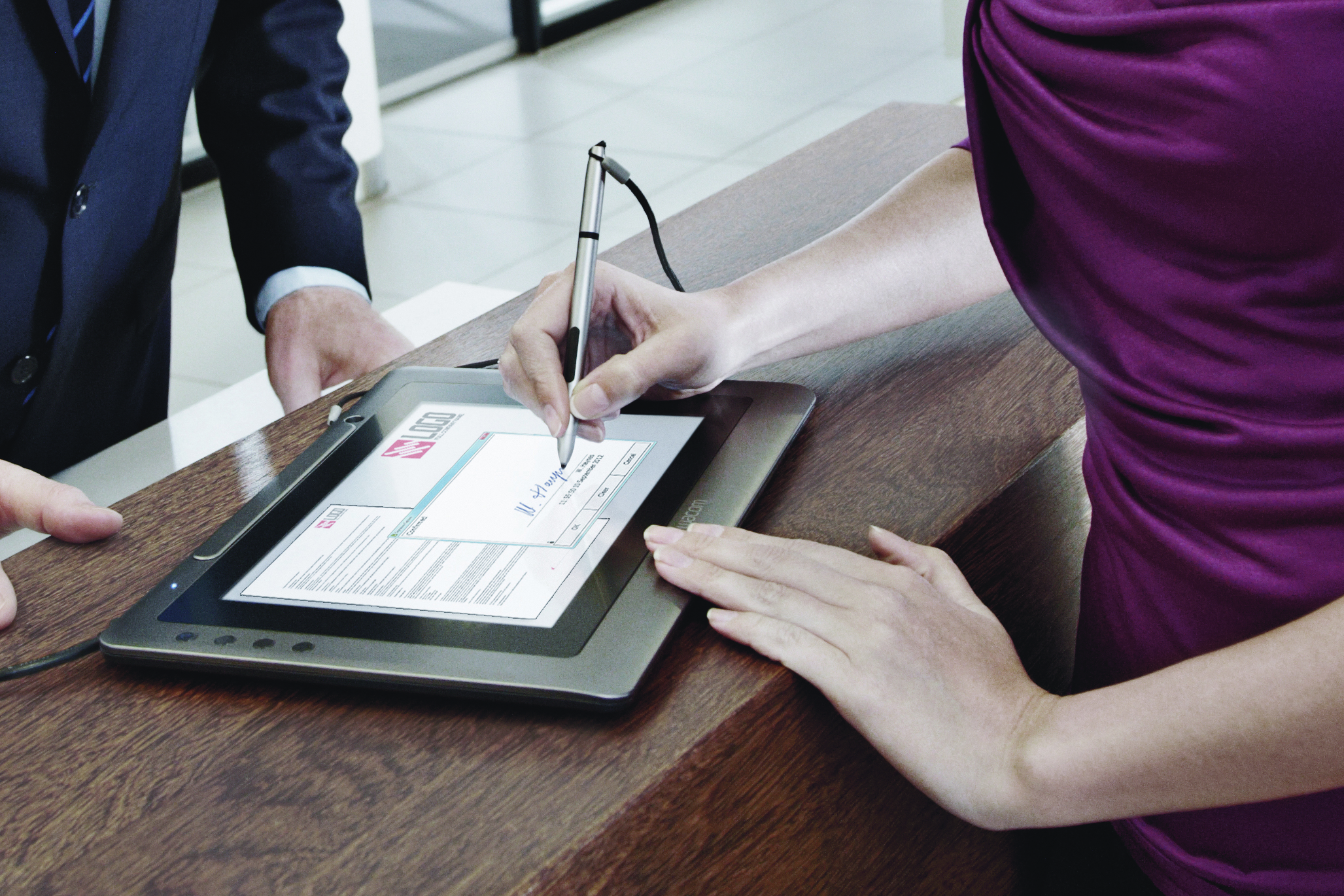Wacom: The digital signature, secure and efficient – Mark Hoole
The consumer banking experience is becoming increasingly digitalised but areas for improvement still remain; lengthy paper trails and susceptibility to fraud are just some of the risks that electronic banking solutions have yet to rectify. Future Banking speaks to Mark Hoole of Wacom about how the company's digital signature pads could drastically improve banking security and efficiency.
What has brought about the need for electronic signature capabilities in banking?
Mark Hoole: It's all down to efficiency and fraud prevention really. We've been in banking throughout Europe for a number of years and over 90% of our market is across Italy where they are benefitting from our products in customer relations, and care and due diligence. If you think about the process in the UK where somebody walks into a bank and has to apply for an account or needs to fill out forms, that procedure can be extremely lengthy; it can take weeks, sometimes months.
However, if you go down the route of using an electronic signature on a digital platform within a bank, then that process can be cut down to, say, 24 hours. Signing an electronic form on a Wacom e-signature device instead means that the document doesn't need to be posted anywhere or passed throughout an organisation; at the press of a key, it can go to all staff responsible and an answer can be provided to the customer within hours.
So the savings on processing time and money that banks are making by using this solution are absolutely huge. We're not talking a few 100,000s here; we're talking millions and billions. That's the main reason for banks to actually say "Yes, we need to start using this". The other, obviously, is fraud prevention.
How do the Wacom signature tablets specifically prevent fraud?
The Wacom solution is very advanced in the way that it can capture a signature at what we call the biometric level; it records the angle, the speed, the pressure, even the airtime that a person takes to go from one letter to another. This enables us to register a signature that is as unique as your fingerprint.
Recently, there have been numerous stories in the media about cracking fingerprints - stealing them off surfaces and using them to break codes. It's the same with iris detection; with a high-definition camera someone can take a picture of your eyes and use that information as biometric data. The benefit of signatures is that they are a physical performance totally unique to each individual and impossible to mimic. I could learn to replicate what your signature looks like but the biometric element could never be copied because I don't know how you hold your pen, how much pressure you use, I don't know how fast you write. And those elements hardly ever change, which is why a biometric signature capture is more secure than anything else on the market.
Are the tablets available for home use as well?
That would be down to the bank, but theoretically yes, they could be. The customer has to go into their branch and produce documents to prove that they are who they say they are, but once that initial process has been done then certainly, if the bank was willing to say "We know you make lots of transactions and it makes sense to provide you with a digital signature pad", then they could do that.
I've been asked in the past if anybody could just buy a Wacom signature pad off the shelf and then use it to sign documents from home instead of going into the bank. Again, yes, that could be done as long as the first registration took place in-branch.
How do Wacom's signature-capture products stand out from those of its competitors?
There are other competitors out there, but we tend to have the edge over them with the design of our pads and the screen technology. A lot of other pads tend to be of what we call a resistive nature - the best way to describe it is similar to the screens that you see when you have to sign for a parcel at your front door. Those are formed of a plastic screen with a film in between two pieces of plastic that pushes together to create the signature. Because they're made of plastic, they're not very durable and therefore have to be replaced every few months or every year. There are more advanced versions within the banking sector but they still use the same technology, the same type of plastic screen.
Wacom pads use a reinforced glass surface; they're so robust you could jump up and down on them and they wouldn't break. In addition, using an imitation plastic pen to sign on them daily means the glass surface can't be scratched, so therefore they last a very long time. If the pen is ever lost, they are very cheap to replace, so that's another unique selling point that we have.
The screen's technology involves the use of an electromagnetic field that enables the unpowered pen to be tracked via electronics it has in the end. The electromagnetic field itself provides an extra element of biometric data by being able to track the pen while it's not actually physically touching the screen; therefore, we can record airtime as well as surface time.
Are some models of Wacom e-signature pads better suited for certain banking environments than others?
It all depends on whether a client wants to view a full document on the screen in front of them or whether they want to look at it on their computer and then sign on a pad. So those are the two elements that denote what type of products we will provide clients with. For instance, for counter service within a bank, branches usually choose our smaller devices, our STU 430 or STU 530 - which is basically just a signature pad with a signing area of 4-5in2. The difference between the 430 and the 530 is the former is monochrome and the latter is colour; monochrome being low resolution, colour being high resolution and also able to display graphics.
So what banks tend to do with these colour pads, is place them on the counter with that month's offers or low interest rates displayed - images that can actually be shown on the pad like a miniature advertising board until it needs to be signed on.
As well as eliminating paper waste, how else do Wacom's solutions ensure sustainability?
The environmental benefit of having these devices is huge because there are no consumables to be used; everything can be viewed and signed for on a screen, so there's no more printing and no more paper trail. Once you start listing all the things you're saving on it's quite a long list: anything from the electricity that runs the printer, to the paper and ink, the time taken to print documents off and then the storage space to house them afterwards.
The most recent figures that I looked at for the UK showed that 18% of floor space in any organisation that uses paper is taken up by storing it; that's nearly a fifth of all industry floor space in the UK is taken up just for paper storage. Implementing Wacom solutions beyond the banking sector could revolutionise this availability of floor space.
What's in the future for Wacom's e-signature technologies?
We have various new products coming out that will make it even easier to view and sign documents in a digital way. We're going to be bringing out several pieces of software that enable 'plug and play' rather than a bespoke piece of software that you would have built uniquely for you. Although we do offer tailored solutions, we also aim to increase the number of off-the-shelf products available.
Also, Wacom has just launched Signpro - a feature that allows consumers to eliminate all printing. If you've got documents already set up as a PDF, or a Word or Excel document, anything that you normally have to print off and sign for your organisation can be viewed, signed, sent and saved all in Signpro.
There's also a solution for the iPad and Android devices that we will be launching shortly so consumers can create a biometric signature on their tablet using a Special Wacom pen; the pen enables you to capture the biometric data as the electronics are in the pen rather than the screen. In terms of the banking sector, this is beneficial for financial advisers out on the road, most of whom already have an iPad or tablet that they show their presentations on to clients. The download will be available soon and it covers all platforms - Windows, Android and iOS. The signature biometrics will not be as detailed as on a Wacom pad, but it enables you to capture a signature that easily qualifies on a legal document.


